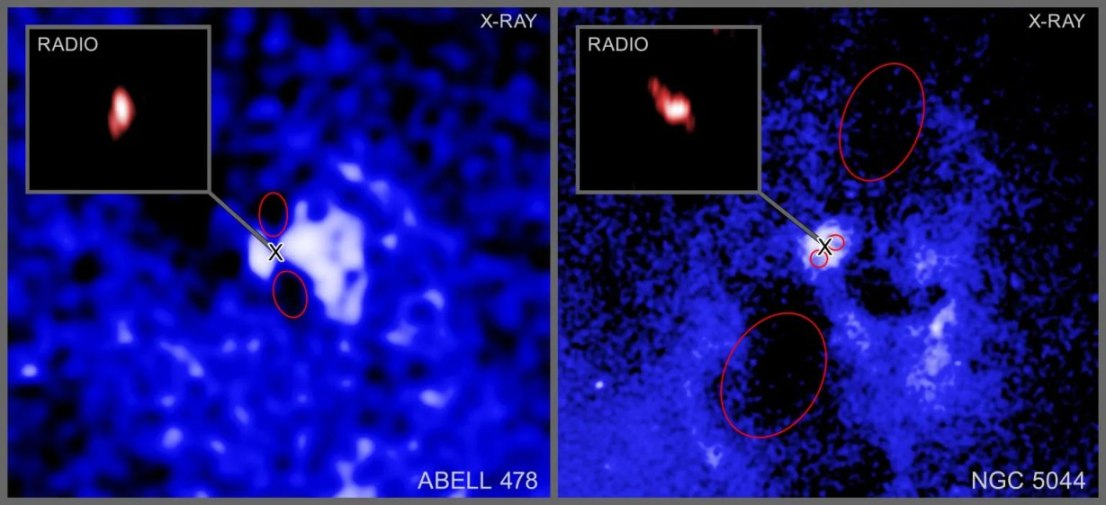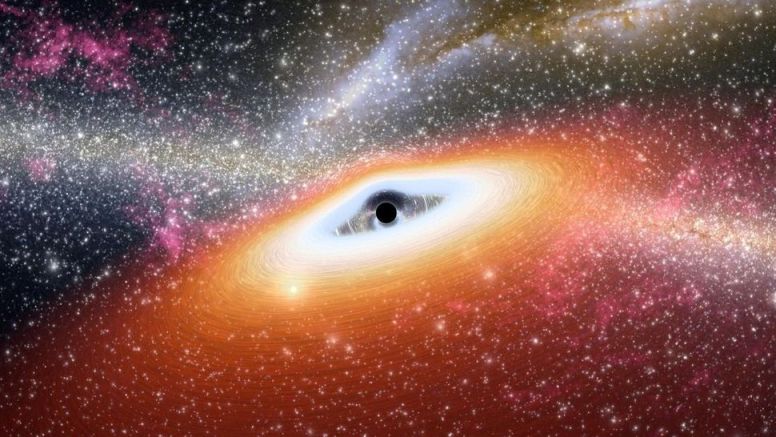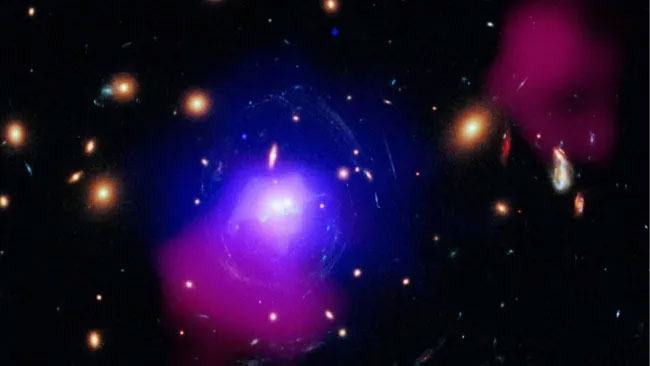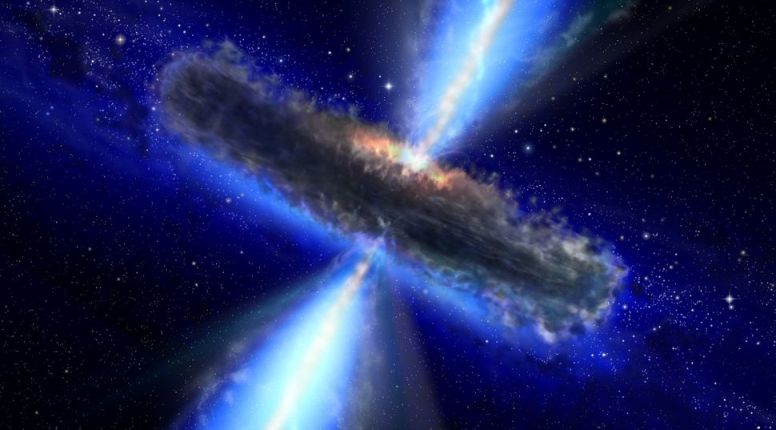A team of astronomers studied 16 supermassive black holes that shoot powerful beams into space to track where the beams, or jets, are pointing now and where they were pointing in the past. Using NASA’s Chandra X-ray Observatory and the Very Large Baseline Array (VLBA) at the National Science Foundation’s (NSF) National Radio Astronomy Observatory (NRAO), they found that some of the beams had changed direction by a large amount.
These two Chandra images show hot gas at the center of the galaxy cluster Abell 478 (left) and the galaxy group NGC 5044 (right). At the center of each image is one of 16 black holes beaming outward. Each black hole is at the center of a galaxy immersed in hot gas.
The images below show the labels and radio images. The ellipses show a pair of cavities in the hot gas for Abell 478 (left), and the ellipses show two pairs of cavities for NGC 5044 (right). These cavities were carved out by rays millions of years ago, indicating the directions of the rays in the past. The X shows the location of each supermassive black hole.

Abell 478 and NGC 5044 (labeled). X-ray: NASA/CXC/Univ of Bologna/F. Ubertosi; Radio inserts: NSF/NRAO/VLBA; Wide-field imaging: Optical/IR: Univ. of Hawaii/Pan-STARRS; Image processing: NASA/CXC/SAO/N. Wolk
The VLBA images are shown as insets that show where the beams are currently pointing as seen from Earth. Both radio images are much smaller than the X-ray images. For Abell 478, the radio image is about 3% the width of the Chandra image, and for NGC 5044, the radio image is about 4% the width of the Chandra image.
Comparison of the Chandra and VLBA images shows that the beams for Abell 478 have changed direction by about 35 degrees, while the beams for NGC 5044 have changed direction by about 70 degrees.
Across the entire sample, the researchers found that about a third of the 16 galaxies had arms that pointed in completely different directions than they had before. Some of them changed direction by nearly 90 degrees in some cases, and on time scales ranging from a million years to tens of millions of years. Given that the black holes are about 10 billion years old, that represents a relatively rapid change for these galaxies.

Wide-field images of Abell 478 [left] and NGC 5044 [right]. X-rays: NASA/CXC/University of Bologna/F. Ubertosi et al.; Optical/IR: University of Hawaii/Pan-STARRS; IR: NASA/ESA/JPL/CalTech/Herschel Space Telescope
Black holes generate rays when material falls into them through a spinning disk of matter, and some of it is then redirected outward. The direction of the rays from each of these giant black holes, which are likely spinning, is thought to be aligned with the black hole’s axis of rotation, meaning the rays are directed along a line connecting the poles.
These rays are assumed to be perpendicular to the disk. If material falls on the black holes at an angle other than parallel to the disk, this could affect the direction of the black hole’s rotation axes, changing the direction of the rays.
Scientists believe that beams from black holes and the voids they create play a major role in the formation of stars in their galaxies. The beams pump energy into the hot gas in and around the galaxy, preventing it from cooling enough to form vast numbers of new stars. If the beams change direction significantly, they could suppress star formation over much larger swaths of the galaxy.
A paper describing these results was published in the January 20, 2024 issue of The Astrophysical Journal. The authors are Francesco Ubertosi (University of Bologna in Italy), Gerritt Shellenberger (Center for Astrophysics | Harvard and Smithsonian Institution), Evan O’Sullivan (CfA), Jan Vrtilek (CfA), Simona Giacintucci (Naval Research Laboratory), Lawrence David (CfA), William Forman (CfA), Miriam Gitti (University of Bologna), Tiziana Venturi (INA – Institute for Radio Astronomy in Italy), Christine Jones (CfA), and Fabrizio Brighenti (University of Bologna).
NASA’s Marshall Space Flight Center manages the Chandra program. The Smithsonian Astrophysical Observatory’s Chandra X-ray Center manages science from Cambridge, Mass., and mission control from Burlington, Mass.
New theoretical research suggests it is impossible to form a black hole using only the energy of light particles, undermining Einstein’s theory of general relativity. A new study suggests that extreme objects known as “kugelblitze” — black holes formed entirely from light — are impossible in our universe, challenging Einstein’s theory of general relativity. The discovery puts significant constraints on cosmological models and demonstrates how quantum mechanics and general relativity can be reconciled to solve complex scientific questions.
Black holes—massive objects with such a strong gravitational pull that not even light can escape their grip—are among the most intriguing and bizarre objects in the universe. They are typically formed by the collapse of massive stars at the end of their lives, when the pressure of nuclear fusion in their cores can no longer withstand the force of gravity.
However, there are more exotic hypotheses regarding the formation of black holes. One such theory suggests the creation of “kugelblitz”, which is German for “ball lightning”. (The plural is “kugelblitze”).
“A Kugelblitz is a hypothetical black hole that, instead of being formed by the collapse of ‘normal matter’ (the main constituents of which are protons, neutrons and electrons), is formed by concentrating huge amounts of electromagnetic radiation, such as light,” said study co-author Jose Polo-Gomez, a physicist at the University of Waterloo and the Perimeter Institute for Theoretical Physics in Canada.
“Even though light has no mass, it carries energy,” Polo-Gomez said, adding that in Einstein’s general theory of relativity, energy is responsible for creating the curvatures in space-time that lead to gravitational attraction. “Because of this, it is possible in principle for light to form black holes — if we concentrate it enough into a small enough volume,” he said.

Einstein’s general theory of relativity states that energy, not mass, is responsible for the curvature of space-time that leads to gravitational attraction. According to this theory, black holes should be able to form from light energy alone. NASA/JPL-Caltech
These principles are valid within the framework of classical general relativity, which does not take quantum phenomena into account. To study the potential influence of quantum effects on the formation of the Kugelblitz, Polo-Gomez and his colleagues studied the influence of the Schwinger effect.
In their study, the team calculated the rate at which pairs of electrons and positrons created in an electromagnetic field would drain energy. If this rate exceeds the rate at which the electromagnetic field replenishes energy in a given region, a Kugelblitz cannot form.
The team found that even under the most extreme conditions, pure light can never reach the necessary energy threshold to form a black hole. This discovery has profound theoretical implications, significantly constraining previously considered astrophysical and cosmological models that assume the existence of Kugelblitzes. It also dashes any hopes of experimentally studying black holes in the laboratory by creating them using electromagnetic radiation.
Nevertheless, the positive result of the study shows that quantum effects can be effectively integrated into gravity-related problems, thereby providing clear answers to pressing scientific questions.
“From a theoretical point of view, this work demonstrates how quantum effects can play an important role in understanding the formation mechanisms and appearance of astrophysical objects,” Polo-Gomez said.
Inspired by their discoveries, the researchers plan to continue studying the influence of quantum effects on various gravitational phenomena of both practical and fundamental importance.
“Some of us are very interested in continuing to study the gravitational properties of quantum matter, especially in scenarios where this quantum matter violates traditional energy conditions,” said Eduardo Martin-Martinez, also of the University of Waterloo and the Perimeter Institute. “This type of quantum matter could, in principle, generate exotic spacetimes, leading to effects like repulsive gravity, or create exotic solutions like the Alcubierre warp drive or traversable wormholes.”
The massive outburst released 100,000 trillion times more energy than the Sun would release in its entire lifetime. Astronomers have discovered one of the most powerful black hole eruptions ever observed. This colossal explosion, which occurred nearly 4 billion years ago, formed a pattern of stars in jewel-like clusters.
The star necklace is adorned by a massive cluster of hundreds of galaxies called SDSS J1531, a body located about 3.8 billion light-years from Earth. The galaxy cluster also contains a huge reservoir of hot gas, and at its center, two of its largest galaxies are in the process of merging into one. The eruption that scientists discovered likely originated from a supermassive black hole in one of these colliding galaxies.
And as these galaxies continue to move toward collision, scientists have been able to discern an S-shaped chain of 19 huge star clusters called “superclusters.”
To study the formation of the supercluster string, astronomers from around the world turned to extensive data across the electromagnetic spectrum, including radio wave data from the Low-Frequency Array (LOFAR) radio telescope, as well as visible light and X-ray data collected by NASA’s Chandra X-ray Observatory. Understanding the formation of this incredible feature could lead to a better picture of how supermassive black holes shape their environments.
“Black hole eruptions like the one that helped create the superclusters in SDSS J1531 are expected to be very important for keeping the gas in galaxy clusters hot,” Timothy Davies, a member of the research team and a scientist at Cardiff University, said in a statement. “Finding such clear evidence of this ongoing process allows us to understand the impact of giant black holes on their environments.”

A strange chain of ‘stellar jewels’ consisting of star clusters formed around a powerful black hole eruption. X-rays: NASA/CXC/SAO/O. Omoruyi et al.; optical: NASA/ESA/STScI/G. Tremblay et al.; radio: ASTRON/LOFAR; imaging: NASA/CXC/SAO/N. Wolk
Supermassive black holes with masses of millions or even billions of times that of the Sun are believed to reside at the centers of all large galaxies. While many of these cosmic monsters lurk quietly, such as Sagittarius A* (Sgr A*), which resides at the heart of the Milky Way, others are gobbling up gas, dust, and even stars around them. These supermassive black holes are part of what are known as active galactic nuclei (AGNs), and are surrounded by disks of gas and dust that feed them. These disks are called accretion disks. The massive gravitational pull of these actively feeding black holes creates turbulent conditions in their respective accretion disks, causing the surrounding environment to glow brightly.
In addition, any matter that does not fall into the supermassive black hole is driven toward the poles of the cosmic titan by powerful magnetic fields. Here, these charged particles are accelerated to speeds approaching the speed of light, erupting as highly collimated relativistic jets from both poles of the black hole. This eruption is typically accompanied by an explosion of electromagnetic radiation in the wavelength range of light.
As a result, active galactic nuclei and their associated quasars are often so bright that they outshine the combined light of every star in the galaxies around them.
The team argues that as a jet erupting from one of the giant galaxies at the center of SDSS J1531 is pushed outward, it is pushing hot gas away from the black hole. The team behind the study believes that this activity has created a giant cavity around the void.
“We are already looking at this system as it was four billion years ago, shortly after the Earth formed,” team leader and Harvard Center for Astrophysics researcher Osase Omoruyi said in a statement. “This ancient cavity, a black hole fossil, tells us about a key event that occurred nearly 200 million years earlier in the cluster’s history.”

The illustration shows jets erupting from both poles of the supermassive black hole at the center of an active galactic nucleus.
Reconstructing this violent sequence of events with Chandra, Omoruyi and his colleagues tracked the movements of dense gas near the heart of SDSS J1531. This revealed bright X-ray “wings” at the edge of the cavity. Radio wave data from LOFAR showed the team the remains of energetic particles associated with the ejecta, the “smoking gun” of evidence for this ancient, powerful eruption.
“There is clearly a very active black hole in this system that is constantly erupting and greatly affecting the gas around it,” Davis said. “Here we are detecting the smoking gun and seeing its impact at the same time.”
The jet’s energy is among the highest ever recorded, Omoruyi explained on the Harvard blog, with the jet releasing 100,000 trillion times more energy than the Sun will release in its entire lifetime.
“As the jet spread out into space, it carved out a giant bubble in the cooling gas, lifting and scattering the surrounding material,” she continued. “Even though it happened nearly 200 million years ago, the legacy of the jet remains. The previously lifted gas has now cooled and is gravitating back toward the center of the cluster, providing fresh fuel for the young ‘bead on a string’ star formation.”
Omoruyi added that while the discovery of this powerful outflow is surprising in itself, one of the most remarkable aspects of this observation is the fact that the overall cluster has remained stable.
What the team has yet to find is evidence of a second powerful jet that could be ejected in the opposite direction and from the other pole of the supermassive black hole. The researchers believe that evidence of this twin jet could be found in X-rays and radio waves with further study.
“We think our evidence for this huge eruption is strong, but additional observations with Chandra and LOFAR will confirm this,” Omoruyi concluded. “We hope to learn more about the origin of the cavity we’ve already detected and to find the one we expect on the other side of the black hole.”
By observing X-rays ejected into the universe by a supermassive black hole, scientists have detected strange flashes that appear to be reflections from the other side of the hole. This is the first direct observation of light coming from behind a black hole, a phenomenon predicted by Einstein’s general theory of relativity but never confirmed. The results of the study are published in the journal Nature.
Stanford University astrophysicist Dan Wilkins was studying a supermassive black hole at the center of a galaxy 800 million light-years away when he noticed something unexpected. Along with the bright X-ray flares, telescopes detected additional flares that appeared later, were dimmer, and had different “colors.” These reflections, or light echoes, were calculated to correspond to X-rays reflected off the back of the black hole.
“Any light that goes into a black hole doesn’t come out, so we shouldn’t be able to see what’s behind the black hole,” Dan Wilkins, a research scientist at Stanford University’s Institute for Particle Astrophysics and Cosmology and SLAC National Accelerator Laboratory, said in a university press release. “The reason we can see it is because the black hole warps space, bends light, and twists magnetic fields around itself.”

An artist’s impression of light coming from behind a black hole. Dan Wilkins
The study initially focused on the corona, an element that some black holes possess. Material falling into a supermassive black hole powers the brightest continuous sources of light in the universe and also forms a corona of X-ray light around the black hole.
The current theory states that the formation of this element begins with gas sliding into a black hole, where it is superheated to millions of degrees. At this temperature, electrons are separated from atoms, creating magnetized plasma. Captured by the powerful rotation of the black hole, the magnetic field bends over the black hole and rotates around itself so strongly that it eventually collapses completely. The situation resembles what happens around the Sun. Therefore, scientists, by analogy with the solar corona, called this phenomenon a black hole corona.
“This magnetic field, associated with and close to the black hole, heats up everything around it and produces these high-energy electrons, which then create X-rays,” Wilkins explains. “I’ve been making theoretical predictions for years about what these echoes would look like to us, so once I saw them in the telescope, I knew what they were related to.”
“Fifty years ago, when astrophysicists started thinking about how a magnetic field might behave near a black hole, they had no idea that one day we would have methods to observe this directly and see Einstein’s general theory of relativity in action,” said another author of the study, Professor Roger Blandford of Stanford’s School of Arts and Sciences and SLAC Professor of Physics and Particle Physics.
The authors will continue to describe and study the coronas of black holes. They have particular hopes for the European Space Agency’s Athena space telescope, scheduled to launch in 2031.




